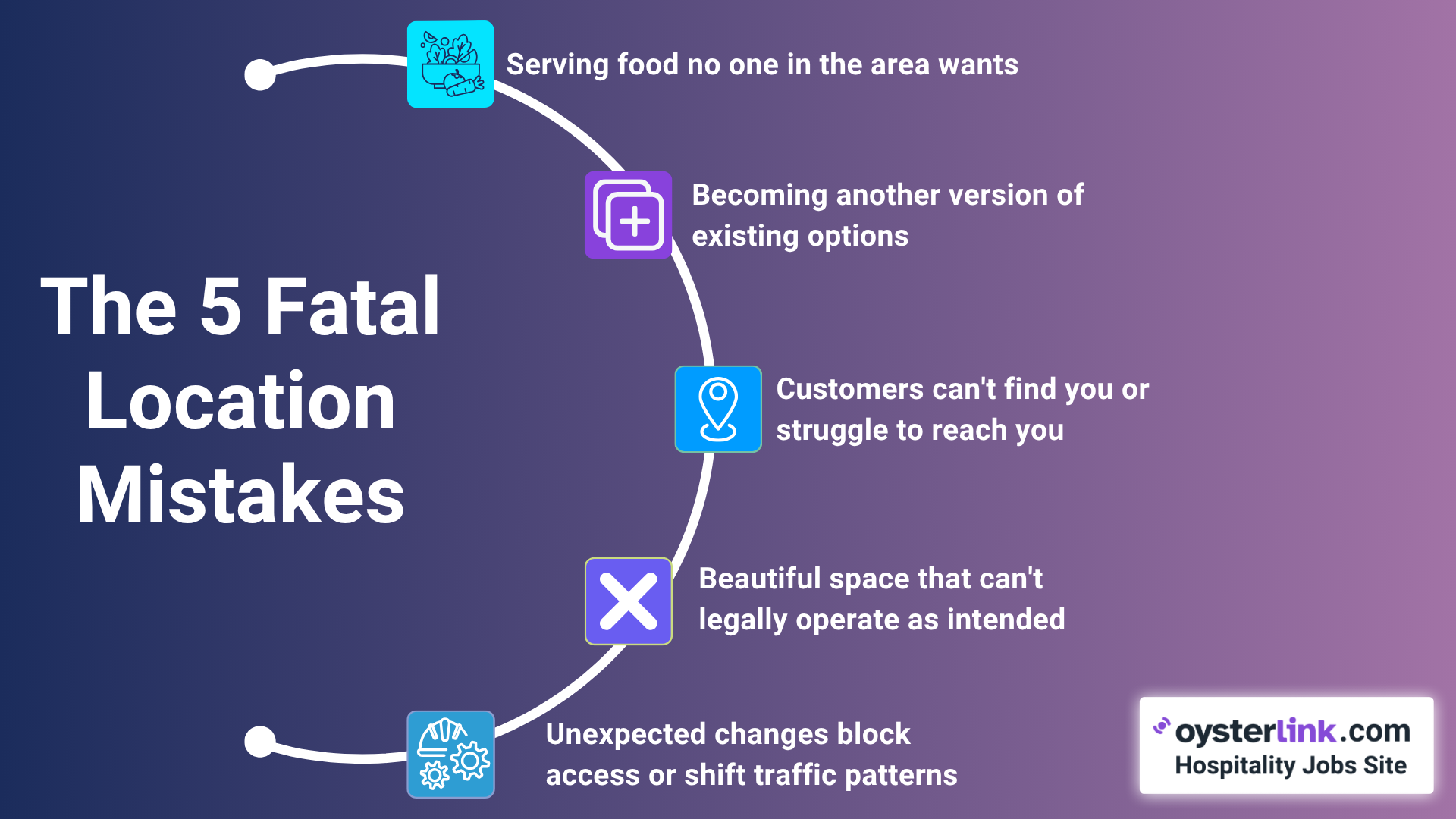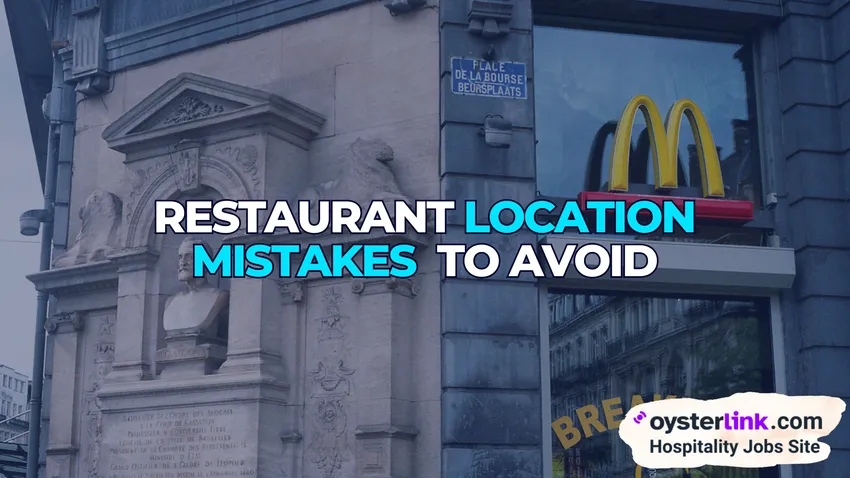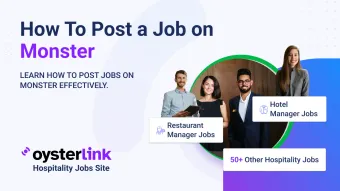Restaurant Location Startegy Mistakes Key Takeaways:
- Millennials currently account for over 30% of all restaurant sales, while Gen Z is the fastest-growing spending group—with 60% of Gen Z making price their top factor in purchase decisions (Business Insider).
- Location success depends on understanding local demographics, including age groups, income and dining habits, to tailor your concept effectively.
- Knowing your direct and indirect competitors is essential; without this, you risk blending in rather than standing out in a crowded market.
- Visibility and accessibility are critical—poor signage, awkward entrances, or limited parking can drive customers away, no matter how strong your concept is.
Choosing the wrong location can silently sabotage your restaurant’s success—from mismatched demographics to poor visibility and legal hurdles.
This guide cuts through the noise and shows you exactly how to avoid these costly mistakes and secure the right spot for lasting growth.
Why Restaurant Location Is a Strategic Decision — Not a Guess
In an industry where approximately 42,000 new restaurant business licenses are issued each year across 470,445 restaurant locations nationwide, your address controls more than just your rent.
It affects the type of customer you attract, how easily you can retain staff and what kind of experience you're able to deliver. It even dictates your hours, your delivery reach and your competitive position.
This isn't just about square footage. It's about giving your restaurant the right foundation to grow on.
Mistake #1: Choosing a Location Without Validating Demographics
Millennials are the largest restaurant spending demographic, accounting for over 30% of all restaurant sales, while Gen Z is the fastest-growing restaurant spending demographic, with their spending expected to increase. Interestingly, about 60% of Gen Z use price as a key factor when deciding which brand to buy from.
Understanding these generational spending patterns is crucial for location success. Restaurants that don't take the time to study the local audience often realize, too late, that they're serving food no one asked for.
What you should do:
Use census data, GIS tools, or platforms like ESRI to get clear on:
- Focus on Millennial/Gen Z concentrations for maximum spending potential
- Cross-reference with your price point strategy
- Occupation mix
- Dining habits (residents vs. commuters, weekday vs. weekend traffic)
Understanding how people live — and eat — in the area gives you the insight to match your concept to real behavior, not just assumptions.
.png)
Mistake #2: Overlooking Direct and Indirect Competitors
In a market with McDonald's and Subway being the most ubiquitous, yet Wendy's leading in foot traffic popularity, followed by Raising Cane's, understanding the disconnect between presence and performance is crucial.
Without a real understanding of what nearby restaurants are offering, you risk becoming just another version of what people already have. If a similar concept already has loyalty, you'll have to work twice as hard for half the traction.
What you should do:
Spend time in the neighborhood. Eat at local spots. Notice:
- Pricing tiers
- Track patterns against industry foot traffic data
- Pay special attention to price sensitivity factors
- Reviews and complaints
Then, create a short matrix that lists your competitors and compares your concept side-by-side. This helps you define your unique angle, whether it's faster service, specialty cuisine, extended hours, or a stronger design-forward atmosphere.
Restaurant success doesn’t depend on being first — it depends on being memorable. Knowing what others do well lets you intentionally focus on what you can do better or differently.
Mistake #3: Choosing a Space With Low Visibility or Awkward Access
Recent data shows 29% of operators reported rising customer traffic between March 2024 and March 2025, up from 13% who reported higher traffic in February, highlighting how critical location accessibility is for capturing this growth.
Poor visibility, awkward entrances, or lack of parking can quietly chip away at your customer base, no matter how much marketing you do.
What you should do:
Before you fall for an “undiscovered gem,” visit the location during different times of day and assess:
- Can the signage be seen from the street or sidewalk?
- Is the lighting adequate after dark?
- Is parking available and easy to find?
- Can delivery drivers and rideshares access it efficiently?
Great restaurants remove friction. If your customer has to struggle to find you, park, or navigate to your door, they may not come back — or come at all.
Mistake #4: Skipping Zoning and Regulatory Checks
A beautiful space with great traffic doesn’t mean much if local ordinances don’t allow for your intended use. Zoning laws, alcohol restrictions and delayed permits can all cause costly setbacks — especially if discovered after lease signing.
What you should do:
Call your city’s planning office with the specific address and confirm:
- Is the location zoned for restaurants or food prep?
- Are there restrictions on signage, outdoor dining, or noise?
- Can alcohol be served, and what licenses are required?
Start gathering this information before lease negotiations begin. If you're planning to open within a specific timeline, the permitting process should be part of your project calendar — not an afterthought.
Involving a real estate attorney or restaurant broker early can help flag issues that even experienced operators might miss.
Mistake #5: Underestimating the Impact of Future Developments
With physical retail accounting for 83.7% of all US retail sales this year, amounting to $6.234 trillion, development pressure on prime locations is intensifying.
Future development can block access, eliminate parking, or shift foot traffic patterns in unpredictable ways. It can also raise rents dramatically as the neighborhood evolves.
What you should do:
Check your local city planning or development office for:
- Road or transit expansion plans
- New housing, hotel, or retail projects (especially relevant given retail growth trends)
- Proposed zoning changes
Also, speak with nearby tenants and landlords about what they’ve heard — they often know about upcoming changes before they hit official channels.

How to Vet Restaurant Locations Like an Operator, Not a Dreamer
With franchise restaurants typically having higher success rates than independents, there's no shortcut to a good decision — but there is a process that successful operators use consistently.
Build your due diligence framework:
- Track key factors across all potential sites: foot traffic, accessibility, competition, zoning and development plans.
- Walk the block, take notes, photograph signage and observe flow during lunch, dinner and weekends.
- Use tech like Placer.ai for data, but trust your in-person observations too.
Involve professionals early:
- A restaurant broker can surface listings not on the public market.
- A real estate attorney can review lease language and flag risks.
- A seasoned GM can spot layout issues or operational red flags you might overlook
Final Thought: Your Location Is the First Real Business Decision You Make
In a market where only 34.6% of restaurants survive beyond 10 years but the industry continues to grow with $1.5T in projected sales, that decision should be based on more than gut instinct — it should be built on data, strategy and the kind of thinking that looks five years ahead, not just five months.
Give your restaurant every chance to thrive — start with the right address.









Loading comments...